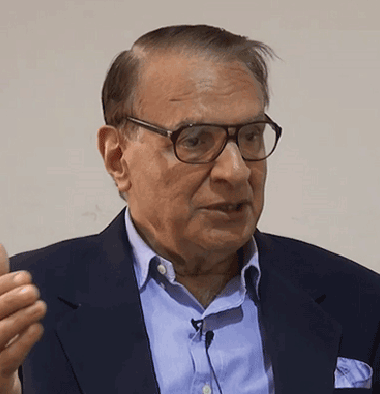-A Commentary-
Ambassador (retd.) Shamshad Ahmad, Pakistan
Introduction:
Regional security environment in Asia Pacific is only an extension of the global security paradigm with all its ramifications for the world at large.
And the world at large today is marked by challenges of the strategic power game involving the nuclear security order, oil politics and economic adventurism, military occupations, invasions in the name of self-defense, human tragedies, and a culture of religion-based extremism and violence.
A Divided World Disorder:
Beginning in late 1989, states, peoples and nations were suddenly freed from the constraining influence of the two ‘blocs’ headed by the United States and the Soviet Union.
This was an extraordinary situation which not only provided the world an opportunity to revert to the concept of collective security and acceptance of the United Nations as an instrument of the new international order, but also engendered hopes that peace would no longer remain hostage to antagonistic heavily militarized blocs.
The emergent reality, however, was totally different.
If ‘containment’ was the key word to describe international diplomacy during the Twentieth Century, ‘Asian Pivot ‘in the name of ‘peace and security’ is its substitute during the present one.
The weird unipolarity, especially in the aftermath of 9/11, has been unleashing its own security challenges for the entire world community, including South Asia.
The concept of global security has changed from its Cold War context only to be replaced by security arrangements at regional and sub-regional levels (e.g. North Atlantic Treaty Organization [NATO], Euro-defense, Balkans, Mediterranean security, ASEAN Regional Forum [ARF] etc.).
Interestingly, NATO, in its new role today, not only stands out as a veritable remnant of the Cold War, but also serves as a convenient military bandwagon to build coalitions that are being used unabashedly to change regimes and to wage wars in the name of peace and security (Afghanistan, Libya and Syria, for example).
In Iraq too, some NATO members were part of the Mission Enduring Freedom. To further complicate the situation, nuclear arsenals now largely shape the global security architecture.
Nuclear weapons have been proliferating vertically as well as laterally to give the erstwhile imperial powers a sense of ‘destiny’ and ‘invincibility ‘.
Old practitioners of power politics seem to dominate the global political scene, stamping out the ‘idealism’ of the United Nations, which today is no more than an instrument for these strategic players to be used for their own self-serving ends.
To them, the nuclear question has traditionally been uni-dimensional, focusing on non-proliferation only as a
concept which they have ingeniously adapted to their own intents and purposes.
Symptom, not the disease, is their problem.
No wonder, the world today witnesses an erosion of arms control and disarmament measures, reversal of non-proliferation policies of the key powers, violation of treaty obligations and weakening of UN disarmament institutions.
Lack of progress towards nuclear disarmament and advocacy by these few powerful states of doctrines such as pre-emption, development and deployment of new war-fighting nuclear weapons and destabilizing systems like the Anti-Ballistic Missiles (ABM) or Ballistic Missile Defense (BMD) are now perpetrating tensions at the regional and global levels.
Also, continuation of long-outstanding regional disputes, emergence of new forms of conflicts, which emanate from power asymmetries, as well as economic and social disparities and injustices, continue to obstruct the objective of equal security for all.
The events of the last decade or so representing a critical threshold in the world ‘s new strategic matrix have immeasurably shaken the international system which is no longer governed by the rule of law or universally acknowledged norms. Countries today find that they have to fend for themselves in a local or regional and quite often
hostile environment.
In this dreary backdrop, the emerging security scenario in Asia Pacific looks like re-enactment of the Cold War with the concept of collective security and acceptance of moral and legal imperatives enshrined in the UN Charter no longer remaining the basis of the global security order.
Already, there has been unprecedented erosion in the role, authority and credibility of the UN which is no longer the sole meaningful arbiter on issues of global peace and security.
What aggravates this bleak scenario is the growing inability of the international community to respond to these challenges with unity of purpose.
There is no global consensus on major peace and security issues or on how to address them.
Historical grievances and outstanding disputes remain unaddressed. Palestine is tired and has given up. Kashmir is disillusioned and feels betrayed. Iraq is still burning. Afghanistan has yet to breathe peace. Libya remains mired in chaos and lawlessness. Iran is on parole, and Syria is in the line of fire.
Asia Pacific and South Asia Security: Is There or Isn’t There?
Yes, the Cold War is long over, but Cold Warriors are still out there in the drivers’ seat. A power-led and oil & gas-driven Great Game is already on with serious ramifications for global peace and security and concomitant tensions and instability in what we call the Asia Pacific regions. While countries and nations in the West have been able to move away from the bitter antagonisms of the past to embrace peace, Asia ‘s major regions continue to be a global hotspot.
Major sources of tensions and conflicts in these regions include the prospect of potential turmoil in post-2014 Afghanistan, ongoing power-play in Central Asia, the Indo-U.S. military and nuclear nexus with its destabilizing effect on the prospects of peace in South Asia, unabated tensions on the Korean Peninsula, the volatile situation across the Strait of Taiwan and challenges of triangular relations among Japan, the U.S. and China, or even in an expanded regional context, pentagonal relations among these three powers, plus Russia and India.
Discriminatory and short-sighted policies for narrow gains giving country-specific preferential access to nuclear technology are further undermining the prospects of peace and security.
If the region‘s turbulent political history had any lessons, the world‘s engagement in this nuclearized area should have been aimed at promoting strategic balance rather than disturbing it.
Policy-makers in world’s major capitals should have been eschewing discriminatory policies in dealing with the India-Pakistan nuclear equation, the only one in the world that grew up in history totally unrelated to the Cold War. But this never happened.
Instead, in 2005, the U.S. signed a long-term multi-billion-dollar military pact with India and then in 2008, it entered into a country-specific discriminatory nuclear deal introducing an ominous dimension to the already unstable security environment of this vast region. What this territory needs is not the induction of new destructive weapons and lethal technologies, but the promotion of peace, stability and economic development.
Any measures that contribute to lowering of nuclear threshold and fueling of an unnecessary arms race between the two nuclear-armed neighbors are no service to the people here.
South Asia needs stability through balance not asymmetry of power. Unless the U.S. revisits its iniquitous nuclear deal with India and matches it with a similar arrangement with Pakistan, the current Indo-U.S. nuclear nexus will continue to undermine the cause of peace and stability.
Obviously, in the face of India’s fast developing capabilities, including its dangerous weapon-inductions, aggressive doctrines and devious nuclear cooperation arrangements, equally dangerous options in response become inevitable.
Pakistan remains opposed to a nuclear and conventional arms race in South Asia and continues to pursue the establishment of a strategic restraint regime with India involving three interlocking elements: conflict resolution, nuclear and missile restraint, and conventional balance.
India, however, remains averse to these proposals and continues to cite extra-regional concerns while its force potential remains overwhelmingly Pakistan specific.
Where Does China Stand?
Meanwhile, the security order in this part of the globe, though still dominated by the U.S., is gradually being balanced by the rapid rise of China which is using its phenomenal economic, political and military influence as a major factor of regional and global stability.
Whatever the global balance of power now entails, China it seems is emerging as the only ray of hope for the Asia Pacific regions. It is already pursuing a policy of peaceful co-existence with all including the U.S., Russia and India which shows its interest in stabilizing rather than destabilizing the world order.
China has also been seeking to build security dialogue and cooperative mechanisms in the Asia Pacific region.
It is pursuing an engagement policy in multilateral frameworks which it claims will remove the apprehensions of other powers as well as its neighboring countries and regions.
But China also has its own regional and global concerns in terms of the challenges resulting from the U.S.-led new unipolarity or its Asian-Pivot-led counterforce arrangements around its borders.
No wonder, in recent years, there has been a conspicuous development of closeness between China and Russia in reaction to what they jointly perceive as growing U.S. strategic outreach in their backyard.
They, especially, share a common interest in curbing Washington’s influence in strategically important and resource-rich Central Asia.
Interestingly, China’s answer to America’s Asian Pivot is not in military terms.

It is in terms of the revival of its traditional ancient Silk Route that it now calls One Belt One Road, a concept involving ‘connectivity’ as a means of socioeconomic growth in Asia, in its own version of America’s post-World War II Marshall Plan. But it is more than the Marshall Plan. It does not involve any ‘post-war reconstruction or rehabilitation’.
China’s Belt and Road connectivity with multidimensional benefits will run through the continents of Asia, Europe and Africa, connecting the vibrant East Asia economic circle at one end and developed European economic circle at the other, and encompassing countries with huge potential for economic development. If anything, this is China’s answer, not
in military terms but in socioeconomic terms, to America’s ‘Pivot ‘. At an estimated cost of $140 billion, this project will in fact link, deepen the multidimensional connectivity between East Asia, South Asia, Central Asia, West Asia, Europe and Africa, putting them all on the cusp of an economic transformation.
Conclusion:
The U.S. should consider joining China in changing the destiny of the world in fulfillment of the vision of its own Eighteenth Century visionary philosopher Thomas Paine who in his common sense had visualized the United States as a power big enough ‘to begin the world all over again’ and said:
“We must not mortgage our children’s future to pay for the
mistakes of today.
# Author’s remarks at a seminar/conference on “Emerging Security Order in Asia Pacific: Impact on South Asia” (Emerging Trends in the Security Architecture of Asia Pacific) organized by Islamabad Policy Research Institute (IPRI) in cooperation with Hanns Seidel Foundation, 2017.
# The author is a former Ambassador and Foreign Secretary of Pakistan. Our thanks are due to IPRI and the distinguished author of this academic article.
Source: IPRI journal, 2017. Thanks IPRI: Upadhyaya N. P.

